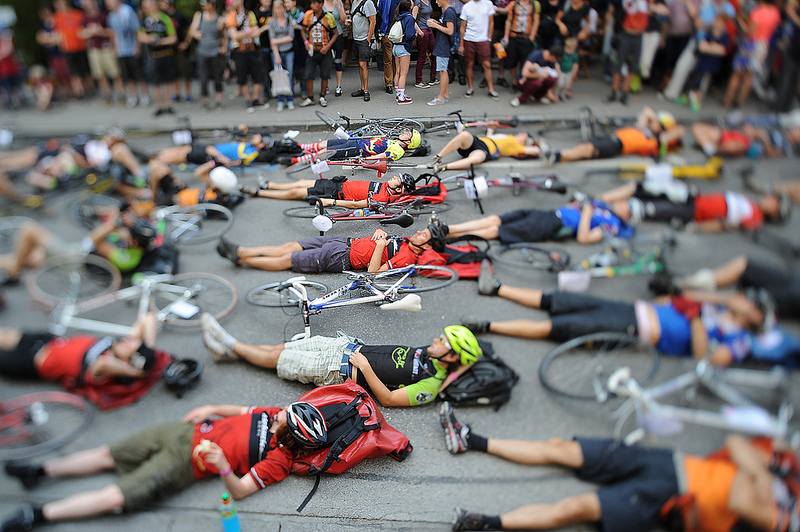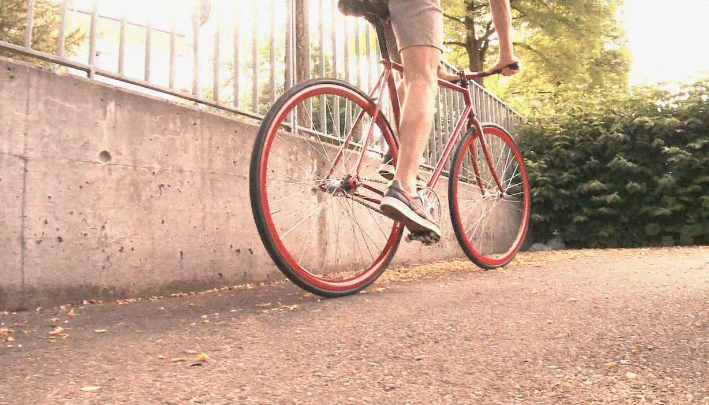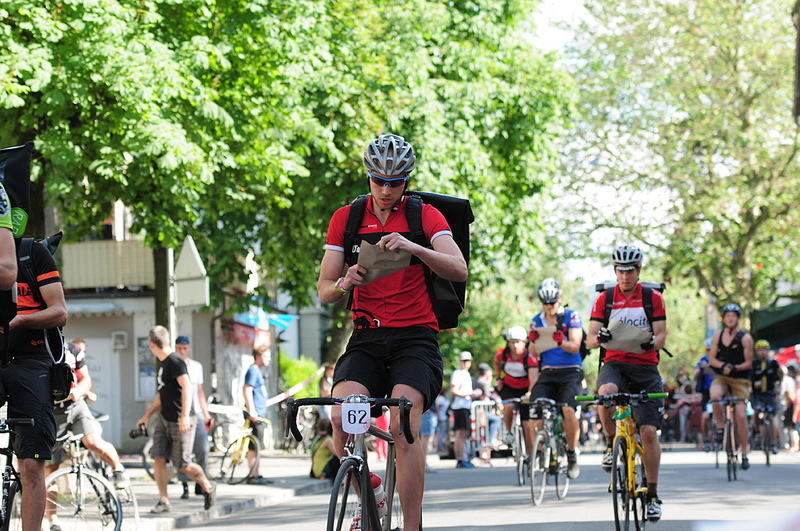A day at the races, delivering packages

Lying down in the middle of a Bern street, the cyclists silently contemplate what’s ahead: a race that will crown the best bicycle messenger on the continent. But the skills on display here aren’t always what they need in their day job.
The moment of zen over, the riders take to their bikes and line up for the race. The atmosphere is festive in the capital city’s Lorraine neighbourhood as the starting signal sounds to kick off the final round of the European Cycle Messenger Championships.
“Only the best will make it to the end!” shouts the race organiser through a megaphone while the riders check their bag straps and glance at their maps, trying to memorise the order in which they will deliver their packages.

More
The bike, reborn as a fashion statement
They will ride three rounds, or “manifests,” after which the field of 50 will be cut and the fastest will go on to ride another one or two rounds to the finish, depending on time. Each manifest means another round of packages to deliver, another route to memorise. It will be a long race.
Laurent, a rider from Geneva who owns a bike courier shop, has been racing for almost ten years. For him, riding doesn’t get old even though he does it for work and play, and these races with riders from around the world are a networking opportunity.
Racers get a map of the course and a “manifest” of where they must pick up and drop off packages; the order is mostly up to them. The field is cut continuously from a qualifying round to a final, then down to just a dozen or so riders who ride the last round to determine overall winners who take home trophies and freebies like new bike tyres and messenger bags.
Bikers can also take part in other competitions at the event, including:
* Longest tyre skid mark
* Best sprinter
* Longest track stand (staying nearly motionless on a bicycle for the longest amount of time)
“It’s a time to meet other people from other cities in Europe, to talk to other people about how they work in their cities, understand what kind of jobs they do. Some deliver food; some only deliver express mail.”
Natalie, another rider from Geneva who’s one of the ten women in the race, agrees – she traded city life for the mountains and now works in a ski school instead of a bike courier shop. But, she still competes “because it’s a family; I want to be here and race.”
Speedy Swiss
“Velo! Velo!” echo the shouts of the orange-vested volunteers who must work tirelessly to keep bystanders from getting run over by speeding racers as they attempt to cross the street. The riders can come from any direction, since they choose the order in which they will deliver their packages to various checkpoints scattered throughout the neighborhood, looking to minimise how many kilometres they have to ride by taking the most efficient route.
These aren’t quite the same challenges couriers face in their everyday jobs, according to Swiss rider Armin Biehler.
“Racing has a lot to do with orienteering,” he says. “There are many who have experience with that, especially among the women. The everyday riding in the courier business is a bit different, because then you’re riding in traffic. And if you’re good at dodging traffic, you don’t really need that in the race. Here, you just need speed and orientation.”
Dominik Guggisberg, the director of the Bern Bike Courier business that’s marking its 25th anniversary this year, believes racing is simply a more intense version of everyday riding.
“Your body is pushed to the limit but you still have to have enough blood in your head so you can think,” he says. “You might have several deliveries to make at once, and you have to know the addresses, the prices, contact names. In everyday courier work, you have a dispatcher who can help you, but in the race you have to do it yourself.”

Biehler adds that the deep-seated orienteering culture in Switzerland means Swiss racers tend to do quite well in courier competitions – the vast majority of racers in the final race are Swiss, with a few from Germany and one from Stockholm, though racers from Ljubljana to Beirut competed in the qualifying rounds.
“The Swiss are traditionally really good. The Americans too, they’re kind of hipsters and also make an impression on the international scene,” Biehler says with a chuckle.
Fashion statements
Most couriers admit, sometimes with a mix of pride and annoyance, that their way of life has spawned a sort of culture that has found its way into the mainstream, from “fixie” fixed-gear bikes to messenger bags and caps.
“We notice that among young people, the bike has become a bit of a status object in Bern in recent years,” Guggisberg remarks. “A new bike culture has emerged.”
But every piece of a bike courier’s outfit serves a purpose, from the roomy, weather-proof shoulder bag to the brimmed hats that keep away sun and sweat. The video below shows a Bern courier getting ready to head out on the job.
Laurent thinks the attention to courier culture is “good, but we don’t always demonstrate the best way to ride a bike in town, because we go into traffic, we don’t look for bike lanes, so it’s not always an example for casual bicyclists.”
Work versus play
When it comes to training young couriers, Guggisberg says there’s a lot to think about when teaching them to be speedy couriers instead of casual riders.
“At first, a new rider always goes out with a partner who shows them how things work – the main clients, package delivery at the train station, the best routes,” he explains. “We also make sure we don’t have too many new people out at one time, because especially at the train station, a lot can go wrong – if you deliver something to the wrong place in the city, it’s no big deal, but if you send a package to Geneva that should have gone to Zurich, that’s a bigger deal.”
From July 30 to August 4, 2013, couriers from around the globe compete in Lausanne for the title of the world’s best bike messenger. Last year’s competition was held in Chicago, and next year’s will be in Mexico City.
Every city has its challenges for bike couriers – Lausanne has its famous hills, while Bern has “a bit of everything,” according to Guggisberg: trams and buses operating on narrow streets, hills, and numerous bridges.
In Switzerland, most couriers operate as part of a business, whereas cities like Berlin and New York have many independent couriers who operate as part of a larger dispatch network, like taxis.
Tokyo is said to have the highest concentration of bicycle couriers in the world.
Although technology has led to less demand for bike couriers in some areas – notably photography and printmaking, where physical versions usually aren’t needed anymore because of digital technology – Guggisberg believes demand from other sectors, like blueprints in the construction industry and medical deliveries, will never wane.
And Biehler thinks the next generation of bike couriers– and courier racers – will be focused on delivery of large items.
“The city centres are becoming increasingly car-free, so you use cargo bikes to go get stuff,” he says. “Or it functions as a delivery service – people shop and can have their things at their door within an hour. That’s the future.”
In Bern, the race is about halfway over, with three manifests complete, and Laurent is watching from the sidelines having a beer. He didn’t make the cut into the final group of racers, but “that’s okay,” he says with a smile. He’s just enjoying the atmosphere.

In compliance with the JTI standards
More: SWI swissinfo.ch certified by the Journalism Trust Initiative

You can find an overview of ongoing debates with our journalists here. Please join us!
If you want to start a conversation about a topic raised in this article or want to report factual errors, email us at english@swissinfo.ch.